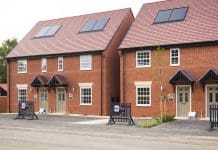Dry fix solutions have been around for decades but it is only in recent years that demand for the product has reached sky high. Mark Parsons, Technical Director at Russell Roof Tiles takes a look at why dry fix has seen such significant growth recently within the construction industry
From its early inception 25 years ago, dry fix products have been renowned for providing a high-quality roofing solution with excellent waterproof credentials. From dry verge systems to dry ridges, the products are designed to be easily mechanically fixed or interlocked with tiles to provide a neat roofing finish and can be fixed with just a few tools in minimal time – saving time and money and helping a roof remain maintenance free for years.
Historically, dry fix was used more across the North of England and Scotland where there were harsher weather conditions, as it provided a strong and sustainable solution, but as weather changed over the past few years, so did the need for a dry fix solution in all areas of the country.
In the last 12 months for example, the UK has experienced some of its harshest weather in record. Severe storms gripped the whole country in February 2018 and Hurricane Ophelia brought strong winds to the west of the UK in November 2017 and while it may be summer now, the weather is only expected to get worse in winter. The construction industry has to be prepared now to avoid issues later in the year.
However, the dramatic change in weather patterns was recognised back in 2012, when the National Housing Building Council (NHBC) stated that all ridge and hip tiles had to be mechanically fixed, as this would help the roof and tiles remain strong and durable in bad weather conditions. Then in 2014, the BS 5534 Code of Practice for Slating and Tiling highlighted that mortar bedding for ridge, hip and verge tiles was no longer deemed to be a long term secure reliable fixing method as well. Roofing now required a more sustainable solution.
 This pioneered the way for dry fix to make its mark in the industry. As a result, builders, contractors and developers now all see the benefits of the product and dry fix solutions were soon adopted across all regions of the UK because it was a quick, secure and more cost-effective method for all weather conditions.
This pioneered the way for dry fix to make its mark in the industry. As a result, builders, contractors and developers now all see the benefits of the product and dry fix solutions were soon adopted across all regions of the UK because it was a quick, secure and more cost-effective method for all weather conditions.
Roofing manufacturers are required to work closely with their customers on providing suitable dry fix specifications and have invested heavily in new equipment and product innovation to ensure demand is met efficiently and quickly.
For instance, Russell Roof Tiles, which was one of the first manufacturers to bring dry fix to the market, has recently invested £85,000 in upgraded dry verge injection moulding machinery equipment and technology to ensure the best customer service.
The demand for dry fix solutions also brought with it a greater need for regulations and earlier this year, the introduction of the new BS 8612: Dry Fixed Ridge, Hip and Verge Systems for Slating and Tiling – Specification standard was introduced.
The new standard helps in preventing some inferior and inadequate dry fix products from being sold, as it specifies the requirements and methods of testing for dry fix products by setting out both quality and performance criteria.
When looking for a suitable roofing solution, housebuilders, contractors and developers will now have more control of their products and should now get the assurance they deserve as they can ensure that the standard is being met in all fixing specifications and their roofing solutions are durable and long-lasting.
It is important that manufacturers continue to work closely with contractors and developers to ensure that they have the best fixing specification which in turn ensures a sustainable and reliable roofing solution. As dry fix products continue to grow in popularity, this will become more important than ever.
Russell roof tiles
Telephone 01283 517070
Twitter: @russellrooftile
LinkedIn: Russell Roof Tiles
Instagram: @RussellRoofTiles











![[Video] Fireco: 80 new fire doors required for residential flats in London](https://www.pbctoday.co.uk/news/wp-content/uploads/2025/04/2024-06-01-Lords-view-one_1200x750_004-218x150.webp)


